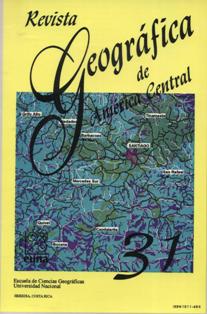MODELO GEOMORFOMETRICO APLICADO AL ESTUDIO DE LA EROCION EN CARCAVAS
Abstract
En la zona de Santiago de Puriscal, Costa Rica, se desarrollo un estudio de carácter geomorfológico, con el objetivo de obtener un modelo empírico que permitiera identificar las áreas más críticas que podrían ser afectados por procesos de erosión severa. A partir del análisis exhaustivo de fotografías aéreas, mapas topográficos, monitoreo de la erosión y trabajo de campo, se logro establecer una significativa correlación espacial entre la ocurrencia de cárcavas de laderas (valley-side gullies), pendiente del terreno y densidad de drenaje de primer orden (Dd1). Con estos resultados se ha propuesto el diseño de un modelo empírico, de fundamentos geomorfométricos, que facilita la zonificación, a nivel regional, de la susceptibilidad diferencial al desarrollo de formas erosivas severas como las cárcavas, terracetas y remoción en masa.
La aplicación del modelo
Geomorfométrico a otras zonas del país como Tilarán, Santa Cruz, Liberia, Hojancha y Buenos Aires brindó resultados semejantes a los de Puriscal, demostrándose con esto su calidad de modelo exportable
La aplicación del sistema de información geográfica IDRISI, facilito enormemente al análisis espacial y estadístico de los datos generados y procesados en esta investigación.Downloads
How to Cite
Issue
Section
License
Proposed policy for journals offering Open Access
Authors publishing their works in the Journal acknowledge and agree to the following terms:
a) Authors retain the copyrights to their works and guarantee the Journal the right to be the first to publish their works, under the Creative Commons License Attribution-NonCommercial-ShareAlike 4.0 International, CC BY-NC-SA 4.0 International (https://creativecommons.org/licenses/by-nc-sa/4.0/deed.es), which allows others to share works upon complying with the acknowledgment of authorship and mention of the Journal as the original publisher of the work.
b) Authors are permitted to separately establish additional agreements for the non-exclusive distribution of the official edition of the work published in the Journal (for example, authors may desire to place the work in an institutional repository or incorporate it into a book that is to published elsewhere) so long they acknowledgment to recognize the Journal as the original publisher. The aforementioned additional agreements must respect the terms of the non-profit character and sharing philosophy of the original license (CC BY-NC-SA 4.0 International, https://creativecommons.org/licenses/by-nc-sa/4.0/deed.es).
c) Authors are encouraged to archive the post-print or editor/PDF version in Open Access repositories.






 REVGEO is licensed under https://creativecommons.org/licenses/by-nc-sa/4.0/deed.es
REVGEO is licensed under https://creativecommons.org/licenses/by-nc-sa/4.0/deed.es
.svg_4.png)

_(1).png)
_(1)_(1)_(1)_1.png)
(2)(1)(1)(1).png)
